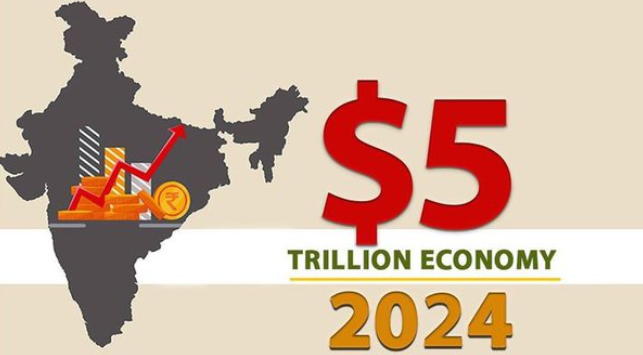What is 5 Trillion Dollar Economy Goal of India?
The term “5 Trillion Dollar Economy” refers to the economic goal set by the Indian government to reach a gross domestic product (GDP) of $5 trillion by 2024-25. This ambitious target aims to transform India into a global economic powerhouse and improve the living standards of its citizens.
Background
In 2019, during his Independence Day speech, Prime Minister Narendra Modi announced the vision of making India a $5 trillion economy by 2024-25. This goal was set to boost economic growth, create employment opportunities, and attract foreign investments.
India’s GDP stood at $2.94 trillion in 2019, making it the fifth-largest economy in the world. To reach the $5 trillion mark, India needs to maintain an annual growth rate of approximately 8-9% over the next few years.
Challenges
Achieving the $5 trillion economy goal presents several challenges for India, including:
- Infrastructure: India needs to invest heavily in infrastructure development, including roads, ports, airports, and power generation, to support economic growth.
- Skill Development: Enhancing the skills of the workforce is crucial to meet the demands of a growing economy and attract foreign investments.
- Ease of Doing Business: Improving the ease of doing business by simplifying regulations, reducing bureaucratic hurdles, and promoting transparency is essential to attract investments.
- Agricultural Reforms: Modernizing the agricultural sector, which employs nearly 50% of the workforce, is necessary to boost productivity and income levels.
- Global Economic Slowdown: The ongoing global economic slowdown, exacerbated by the COVID-19 pandemic, has posed additional challenges to India’s growth trajectory.
Strategies and Initiatives
To achieve the $5 trillion economy goal, the Indian government has introduced several strategies and initiatives, such as:
- Make in India: This initiative aims to promote manufacturing in India, attract foreign investments, and create employment opportunities.
- Digital India: The program focuses on transforming India into a digitally empowered society and knowledge economy by increasing internet connectivity and promoting e-governance.
- Skill India: This initiative aims to provide vocational training and skill development to the youth, making them employable and promoting entrepreneurship.
- Smart Cities Mission: The mission aims to develop 100 smart cities across India, focusing on sustainable urban development and improving the quality of life for citizens.
- Atmanirbhar Bharat Abhiyan: Launched in response to the COVID-19 pandemic, this initiative aims to make India self-reliant by promoting local manufacturing, reducing import dependence, and boosting domestic consumption.
Progress and Milestones
India has made significant progress towards achieving the $5 trillion economy goal, despite the challenges posed by the COVID-19 pandemic. Some notable milestones include:
- Improved Ease of Doing Business: India’s rank in the World Bank’s Ease of Doing Business index improved from 142 in 2014 to 63 in 2020.
- Foreign Direct Investment (FDI): India attracted FDI inflows of $81.72 billion in the financial year 2020-21, the highest ever recorded.
- Startup Ecosystem: India has emerged as the third-largest startup ecosystem in the world, with over 50,000 startups registered.
- Digital Payments: The adoption of digital payments has increased significantly, with the value of digital transactions reaching $270 billion in 2020.
Sectoral Focus
To achieve the $5 trillion economy goal, the Indian government has identified key sectors that have the potential to drive economic growth. These include:
- Manufacturing: The government aims to increase the share of manufacturing in GDP from 16% to 25% by 2025.
- Services: The services sector, which contributes around 55% to India’s GDP, is expected to play a crucial role in achieving the $5 trillion target.
- Agriculture: Modernizing the agricultural sector and doubling farmers’ incomes by 2022 is a key focus area for the government.
- Infrastructure: Developing world-class infrastructure, including highways, railways, airports, and ports, is essential to support economic growth.
- Energy: Ensuring energy security and promoting renewable energy sources are critical for sustainable economic development.




